NAGOYA
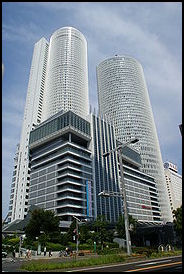
Central Towers Nagoya (2 hours by bullet train southwest from Tokyo) is a major industrial center and Japan's forth largest city. Home to 2.3 million people, with 7.2 million people in its metropolitan area, it is the capital of Aichi Prefecture and center of commerce, industry, and culture in central Japan (the Chubu Region) . It is located between Tokyo and Osaka on Japan's major east-west highway and railway systems.
Nagoya is 370 kilometers (230 miles) southwest of Tokyo and 200 kilometers (120 miles) northeast of Osaka. It is not a major tourist destination but is easier to deal with than Tokyo and Osaka and makes a good jumping off point for places in Gifu and the Japan Alps.
For a long tine Nagoya has been maligned for being a second rate city and the Japanese equivalent of Detroit. Comedians made fun of the unfashionable clothes and funny accents of Nagoya people and their habit of visiting the airport for a night out . But things have changed in recent years. The success of Toyota and the Aichi Expo in 2005 and the opening of a new international airport. have given the city a new confidence. It has a booming economy, one of Japan’s lowest unemployment rates and best real markets. There has even been talk of “Nagoya chic.”
Aichi Prefecture covers 5,172.5 square kilometers (1,996 square miles), is home to about 7.5 million people and has a population density of 1,447 people per square kilometer. Nagoya is the capital and largest city, with about 2.3 million people. It is in Chubu in central Honshu island and has seven districts and 54 municipalities. Aichi is still regarded as a major center of traditional crafts. Among the crafts that are made there are calligraphy brushes, furniture, cloisonne ware, tie-dyed cloth, dyed garments, ceramics, stonework, Buddhist altars, and Buddhist altar implements.
Tourist Information: The Nagoya city tourist information office is inside Nagoya Station. Better is the Nagoya International Center (tel. 052-581-0100) within the International Center (Kokusai Center). Orientation and Transportation: Nagoya is laid out in a grid and fairly easy to negotiate. Nagoya has a subway system and an extensive network of train lines that acts like a subway system. Nagoya Train and Subway p: Urban Rail urbanrail.net
Websites:Nagoya Convention and Visitor’s Bureau ; City of Nagoya City of Nagoya Map: On the World Map ontheworldmap.com Hotel Web Sites: Hotels Combined Hotelscombined.com ; Ryokan and Minshuku Japanese Guest Houses Japanese Guest Houses Budget Accommodation: Japan Youth Hostels Japan Youth Hostels Check Lonely Planet books Getting There: Nagoya is accessible by air and by bus and by train on the main shinkansen line from Tokyo (two hours) and Osaka (two hours) and other Japanese cities. Lonely Planet Lonely Planet
Entertainment, Restaurants and Accommodation: The Aichi Performing Arts Center is a huge complex with a concert hall, theaters, and museum space.The Sakae entertainment and shopping quarter boast has 300 shops and restaurants packed around "Crystal Object" Square. Most places to stay and eat are around Nagoya Station and the Sakae commercial and entertainment district. Nagoya is home to more than 10 deluxe hotels and roughly 90 business and standard hotels. Nagoya has the third largest fish market in Japan but visitors are generally not welcome. There are some sushi and seafood restaurants around it. Website: Nagoya Info nagoya-info.com ; Nagoya: The most boring city in Japan Japan Times ;
History of Nagoya

There is a lot of history associated with Nagoya. All three of Japan's greatest heros — Oda Nobunaga, Toyotomi Hideoyishi and Tokugawa Ieyasu — were born in Nagoya or nearby. Not much remains from their era. Nagoya was heavily bombed in World War II. Most of the buildings have been built after the war.
According to “Cities of the World”: “Nagoya and its residents have long been associated with commerce and merchandising. Located along the historical transportation routes between eastern and western Japan (between Edo, or Tokyo, and Osaka), the town prospered from its trade with both regions. Among the important early regional industries were textiles, steel-making, and ceramics, traditional economic activities whose imprint is still evident today. [Source: Cities of the World, Gale Group Inc., 2002, adapted from a 2001 U.S. State Department report]
“The first of Japan's Tokugawa shoguns, Tokugawa leyasu, recognized the town's strategic importance in the early 17th century and built an imposing castle in its center. Ruled over first by one of his sons and then by other Tokugawa successors, Nagoya grew both in economic and political importance during the long, and virtually warfare-free, Tokugawa era. Over time, the city and the surrounding area became the commercial and industrial hub that it remains today. The castle built by the shogun, leveled along with the rest of the city during World War II, was rebuilt and remains the premier landmark in and symbol of the city.
“Regional civic and business leaders are pushing ahead with several large scale 21st century projects in and around Nagoya. Already in place is a giant new commercial development, JR Central Towers, which opened in downtown Nagoya over the city's main train terminal in March 2000.” In 2005 the new Central Japan International Airport opened and the region hosted the 2005 World Exposition. The airport cost $7.2 billion and was built on landfill in Ise Bay about 35 kilometers south of Nagoya. Plans for the World Exposition (EXPO 2005) were scaled back from the original conception but the project was still an enormous undertaking, with an investment of about $1.4 billion by the Japanese government, local governments, and the private sector. Expo 2005 was laid out on existing parkland near a forested area adjacent to Nagoya.
Economy and Infrastructure of Nagoya
Nagoya it is famous throughout Japan for its porcelain industry and is the home of Toyota, Mitsubishi Heavy Industries, Kawasaki Heavy Industries, and a number of drug companies. According to “Cities of the World”: “Nagoya and the surrounding region make up an industrial powerhouse. Economic activity in this region is such that even if separated from the rest of Japan, it would still have one of the world's largest economies. This is the center of Japan's automobile and auto parts industries.” Toyota “has its headquarters and virtually all of its Japan operations in Aichi and other car and truck manufacturers are either headquartered or have plant facilities in the region. Mitsubishi Heavy Industries and Kawasaki Heavy Industries, along with other aerospace companies, are located in or near Nagoya. [Source: Cities of the World, Gale Group Inc., 2002, adapted from a 2001 U.S. State Department report]

Toyota headquarters “Other industries, ranging from machine tools to fine ceramics, are located here and form part of the Chubu Region's vast economic base. Some of this manufacturing output is exported out of the Port of Nagoya, the busiest in export volume of all of the country's ports. Nagoya Bay is large enough to accommodate some of the world's largest ships; every year, about 38,000 ships enter the bay to dock at Nagoya's port. In 1999, foreign trade volume in and out of all of the regional air and maritime ports was almost $142 billion.
“The most heavily trafficked highways between Nagoya and Tokyo (the "Tomei") and between Nagoya and Osaka (the "Meishin") both have new partner routes constructed in the 2000s. In addition, Nagoya-based Central Japan Railways is going ahead with development of the " Linear Chuo Shinkansen," a futuristic "maglev" (magnetic levitation) train that could run at speeds as high as 500 kilometers per hour, connecting Tokyo and Nagoya in 40 minutes.
Toyota City and Toyota in the Nagoya Area
Toyota Motor Company — the world's biggest automobile maker in terms of market value and sales — is headquartered and has its oldest plants in Toyota City, a suburb of Nagoya previously known as Koromo. Toyota has 250,000 workers scattered around the world. It employs a domestic, regular workforce of 66,000 people at 12 plants, with 90 percent of them in the Nagoya area. It is regarded as the world's most efficient car manufacturer as well as one of the world's best run companies.
Toyota City, where many of Toyota's employees live, features modern architecture and well-designed neighborhoods but lacks a culture, fun and individualism. There is little public transportation system — a decision that appears to have been purposely made to get people to buy Toyota cars — and the school calender fits Toyota's production schedule. Workers say there is little after-work social life and week-on, week-off night shift disrupts sleeping patterns and family life. [Source: Times of London]
One retired worker who worked for Toyota for 43 years told the Times of London, “In 1959 the city literally became Toyota in name. And that is when Toyota corporate culture came to define the place. Nobody dares stand up. Outside the company there is nothing here to arouse any kind of passion...This city is a completely 100 percent corporate-controlled environment. There is no individualism, no ability to speak out, no democracy, just totalitarianism. It's like North Korea."
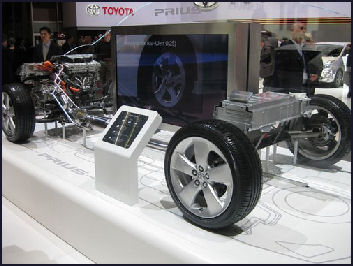
Toyota hybrid drive train The wife of the worker who died from overwork sued Toyota for overtime money she felt was owed her family. She told the Times of London, “people in this city must learn to have their own views of what is right and what is wrong. People here are only good at following company rules. They have no idea how to follow an independent thought."
Toyota runs its own high school, the Toyota Technical Skills Academy in Aichi, where students are given training in math and science geared specifically for the needs of Toyota and prepared to be supervisors in the mechanical, machining and technical fields at the heart of the Toyota operation. Founded in 1938, a year after Toyota itself was founded, the school is expensive to run but Toyota says in the long run it saves money in training costs. The school has 300 students. Each year to accepts about 70 fifteen-year-olds who automatically become Toyota employees when they enroll.
Sights in Nagoya
Sights in Nagoya include Nakamura Park, the birthplace of Toyotomi Hideoyishi. Higashiyama Park has a fine zoological and botanical garden. Osu Kannon Temple is near a popular shopping and amusement area. Skyscrapers in central Nagoya include JR Central Towers and Midland Square in front of Nagoya Station. Among the most striking new modern buildings is the Mode Gakuen Spiral Towers in front of JR Nagoya Station.
Nagoya Castle (Shiyakusho station in the Meijo subway lines) is where a James Bond film was shot. Originally constructed in 1612, it was destroyed by fire during World War II and later rebuilt as a symbol of the city. The 150-foot-high donjon, completed in 1959, has an impressive view from the fifth floor which can be reached by an elevator. At either end of the roof look for the famous “shchi-hoko”, dolphin-like creatures.The rooms on the second, third and forth floors have historical exhibits and displays of armor. Ninomaru Garden, on the castle ground is also worth visiting. It has a beautifully-situated teahouses. Website: Nagoya Castle Official site nagoyajo.city.nagoya
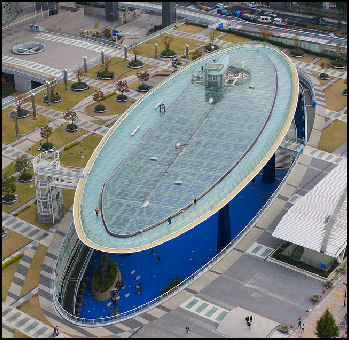
new bus centre Nagoya Ninomaru Garden of Nagoya Castle is a dry garden for strolling constructed in the 17th century. Four tea rooms or teahouses are dispersed in the garden, connected by stepping stone paths and with stone lanterns in between. 5-minute walk from Shiyakusho Subway Station Address: Hommaru, Naka-ku, Nagoya Hours Open: 9:00am-16:30 (Entrance to the donjon until 16:00) Closed: 29 December–1 January Admission: ¥500 Website: http://www.nagoyajo.city.nagoya.jp/13_english/index.html
Atsuta Shrine (Jingu-nishi station in the Meijo subway lines) is said to enshrine the famous grass-mowing sword, one of the three legendary Regalia of the Emperor along the Imperial mirror and jewels. Originally built in the 3rd century, it contain several shrine buildings and a museum with Shinto and Tokugawa artifacts.
Nagoya Port Area has been redeveloped in recent years. The main attractions include the large Nagoya Port Aquarium, with 70 displays, 30 tanks and marine life from Japan, Australia and the Antarctic; the Port Tower (offering good views of the harbor); the Maritime Museum; and the Fuji Antarctic Exploration Ship. Meiko Tritom consists of three cable-supported ocean bridges over Nagoya Port — the 700 meter Meiko East Bridge, the 1,170-meter Meiko Central Bridge and the 758-meter Meiko West Bridge.
Legoland Japan: Japan's First Outdoor Legoland Park
Legoland Park (17 minutes by train from the Nagoya shinkansen bullet train station) Japan's first outdoor Legoland opened in Nagoya in April 2017, Kyodo reported: Japan's first outdoor Legoland park opened in Nagoya with the major new attraction raising hopes that more foreign tourists will visit the area and deliver an economic boon to the country's third largest business region. With children's tickets priced higher than Tokyo Disneyland's, Legoland Japan offers various rides inspired by the Danish construction toy and serves meals including whimsical block-shaped fried potatoes in the seaside premises. "We want children from all over the world to come to Nagoya and make unforgettable memories," Torben Jensen, president of Legoland Japan Ltd., said at an opening ceremony. [Source: Kyodo, April 1, 2017]
”Visitors can stroll down a miniature town, called Miniland, which has models of landmark buildings in Japan, such as Tokyo Station, Kiyomizu temple in Kyoto and a 2-meter-high Nagoya Castle. Some 10 million pieces of Lego plastic blocks were used to complete the miniature town, according to the park's operator. Children can drive go-karts, ride a roller coaster and take a "submarine" tour through a real fish tank in the 9.3-hectare park in the Kinjo Wharf area.
”Jensen told reporters recently that the park's operator plans to expand the size of the premises, open a Legoland hotel and build new attractions to increase the number of repeat guests. Legoland Japan will also enhance cooperation with foreign travel agencies that are contemplating selling package tours whose prices include entrance ticket fees, Jensen said. A local think tank expects the new theme park could give an economic boost worth 96.8 billion yen ($865 million) to Aichi Prefecture, whose capital is Nagoya,. and other areas in fiscal 2017 starting Saturday.
“Ryoichi Namba, economist at the Chubu Region Institute for Social and Economic Research, said that the park, which is only will attract a lot of foreign tourists as only the second Legoland in Asia after one in Malaysia. Namba said "it is premature" to forecast how successful the new Legoland business will be in the long run, but there is a concern that the 5,300-yen ticket price for visitors aged between 3 and 12 could discourage repeat guests. Visitors aged 13 or older pay 6,900 yen. Tokyo Disneyland, meanwhile, charges 4,800 yen for visitors aged between 4 and 11. Universal Studios Japan, a major amusement park in the country's second largest business area including Osaka, charges 4,723 yen for the same ages. Japan already has Legolands in Tokyo and Osaka, but these are indoor theme parks located inside shopping malls. The Nagoya park, the first full-scale outdoor theme park of its kind in Japan, follows in the footsteps of seven similar parks abroad.”
Museums in Nagoya
Tokugawa Art Museum houses over 10,000 articles handed down from Tokugawa family and a famous school related to the Tales of Genji. Tokugawa leyasu has a big impact on Nagoya and Japan as a whole. His role and those of his descendants are featured in the Tokugawa Museum, which contains a splendid collection of weapons, armor, artworks, and other artifacts from that period in Japanese history.
Toyota Commemorative Museum of Industry and Technology (a few minutes from Sako Station in central Nagoya)is fascinated place for anyone with an interest in technology. Founded and curated by the Toyota group, it has an interesting collection of real working machines. Trace the path of Japan’s industrialization from textiles to automobiles and see how Toyotaoriginated as a manufacturer of textile looms. The museum shines a spotlight on Japan’s remarkable history of technological advancement and modernization. Visitors can observe original hand-operated Toyota looms from the 1920s, which formed the foundation for the manufacturing methods and principles the company employs to this day. Then stroll to the Auto Manufacturing Pavilion, where you’ll get a bird’seye view as automobiles are assembled before your eyes. All ages will enjoy Technoland, a hands-on exhibit where you can experience the joy of creation for yourself. Location: 4-1-35 Noritakeshin-machi, Nishi-ku, Nagoya-shi, Aichi Website: tcmit.org/english

Nagoya Aquarium Robot Museum opened October 2006 and closed not long after that. It contained more than 1,000 items including panels on robot history and models of robots, toy robots made in the 1940s and models of favorite robot characters such as Astroboy, Gigantor, Mazinger Z and Gundam. Robots showcased include Honda’s ASIMO and Sony’s Aibo. The museum was set up by an Osaka-based publisher of magazines on robots.
World’s Largest Planetarium Dome is at the Nagoya City Science Museum. It is 35 meters in diameter. Kyodo reported: “The city of Nagoya announced that the planetarium at Nagoya City Science Museum has been recognized by Guinness World Records as the world’s largest. After being renovated at a cost of some 2.5 billion yen, the new planetarium opened in March with a diameter of 35 meters. It breaks the previous record held by Ehime Prefectural Science Museum by 5 meters. The planetarium in the central Japan city boasts a new projector equipped with fiber optics that can show up to sixth-magnitude stars. The brightness of stars is measured on a descending scale of 1 to 6, with sixth magnitude being the faintest. ''We want to use the Guinness record as a trigger to attract people to Nagoya from around the world,'' Nagoya Mayor Takashi Kawamura said. [Source: Kyodo, December 28, 2011]
Boston Museum of Fine Arts Nagoya Branch opened in 1999 and closed in 2018. Located in three floors of an office and hotel complex, it contained a revolving exhibition of paintings from the Fine Arts Museum in Boston that were acquires as part of $50 million, 44-exhibit, 20-year deal between the Nagoya Chamber of Commerce and the Boston Museum. The museum in Nagoya costs $300 million and featured an impressive collection of treasures from ancient Egypt, Greece, and Rome along with more modern works loaned by the Boston Museum. Websites: Kintesu.co ; Wikipedia Wikipedia
Toyota Kaikan Museum
Toyota Kaikan Museum (in Toyota City, 25 kilometers southeast of Nagoya, about one kilometers east of Mikawa-Toyota Station on the Aichi Loop Railway) has exhibits broken down into the following areas: 1) The Environment and Inspiration: See diverse efforts to develop eco-cars with hybrid technologies at their core; 2) Safety and Freedom: Learn about Toyota’s initiatives to create vehicles that do not cause accidents; 3) Production and Creativity: An introduction to Toyota’s approach to manufacturing, human knowledge and innovation needed for car making's various production processes; 4) Company and Society: Information on the Toyota Global Vision, an aspirational statement shared by all Toyota employees, and specific measures from the past, present, and into the future are presented.

Lexus hybrid 5) Car Classroom: A basic introduction to vehicle mechanisms, Toyota’s auto making, traffic safety, and other topics for children (in Japanese); 6) Museum Shop: Offers a variety of automotive-themed goods such as plastic models, miniature toy cars, and books. 6) Toyota Vehicles: An exhibit of the latest Toyota vehicles; 7) Lexus Vehicles: An exhibit of the latest Lexus vehicles; 8) TOYOTA GAZOO Racing: An introduction to motor sports and rally programs and current automotive topics
Location: 1 Toyota-cho, Toyota City, Aichi Prefecture 471-8571, Japan Tel: 0565-29-3345; Hours Open: 9:30am-5:00pm. Closed Sundays, during the Japanese New Year’s holiday, Golden Week, summer vacation period and at some other times. Getting There: About one kilometers east of Mikawa-Toyota Station on the Aichi Loop Railway but seems a little complicated. Check the website toyota.co.jp/en/about_toyota/facility/toyota_kaikan/access
Toyota Factory Tours
Toyota Kaikan Museum offers daily assembly line tours starting at 11:00am. Tour participants are bused to one of three plants in which Crowns, Priuses and 15 other passenger cars are assembled and walk along a walkway above the factory floor. Reservations are necessary. Call ☎ (0565)-23-3922. Website: Toyota site Toyota site
On the plant tours visitors will see the following automobile production processes 1) Stamping: Sheet metal is cut and stamped to form hoods, doors, and other body parts. 2) Welding: Approximately 400 body parts are welded by robots to form the exterior of the vehicle. 3) Painting: The welded body is washed and then given an undercoat, middle coat, and top coat of paint to produce a high-quality painted finish. 4) During the tour of the assembly plant visitors are shown: Various parts are attached to the painted body such as the engine and tires. The fully-assembled vehicle is subjected to a strict quality check in the final inspection process and is then shipped as a finished automobile.
Location: Assembly tours at the Motomachi Plant, Takaoka Plant, or Tsutsumi Plant; Admission: Free. Hours Open: Monday to Friday and Saturday, Sunday, during the Japanese New Year's holiday, Golden Week, summer vacation period/ Tours are available Japanese and English. If an explanation is required in a language other than Japanese or English, visitors are requested to make their own arrangements for interpretation from Japanese. The tour procedure differs depending on the number of visitors. Requests for tours are accepted for one or more visitors. The tour departs from the Toyota Kaikan Museum at 11:00. It is essential to be standing by at the Toyota Kaikan Museum thirty minutes before the tour bus leaves. If you are late you cannot take the tour. Tour Information: Local Tel:0565-29-3355; Overseas Tel: +81 565-29-3355; Website: toyota.co.jp/en
Kirin Beer Factory Tour and Tasting
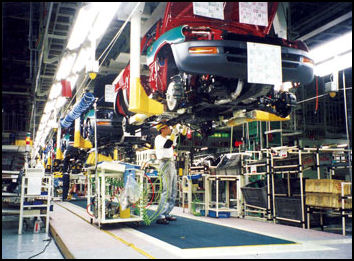
Toyota factory tour Kirin Beer factories are located in nine places (Chitose, Sendai, Toride, Yokohama, Nagoya, Shiga, Kobe, Okayama, and Fukuoka) . Each factory offers free a tour that last around 80 minutes. The Kirin Brewery Company is one of Japan's four leading beer breweries. It was founded in Yokohama, a city that played a major role in Japan's adopting beer from the West and spreading it the rest of Japan. [Source: yokohamajapan.com]
The brewery tours pass through a gallery with displays regarding the history of beer and Kirin and winds its way around parts of the factory, offering views from above through observation windows of various parts of the manufacturing process. As you watch, thousands of cans and bottles of beer go shooting through factory machines at incredibly high speeds! According to the guide, 2000 cans of beer are filled and packed each and every minute. Near the end of the tour, a series of panels of Kirin’s history are on display. Tours are usually conducted in Japanese, but an English guide may also be available.
Beer Production involves boiling down barley to make mash and removing the chaff so the wort can be squeezed out. The bitterness and fragrance of the beer comes from adding hops to the wort and boiling it down again. The entire process takes place in a preparation chamber installed with nine boiling kettles, each 12 meters in diameter. Top quality beer are often made using only the first press of the wort. Fermenting takes place inside 129 huge tanks for a period of one or two months. Visitors can try the first and second press of the wort for comparisons as well as up to three glasses of draft beer drawn straight from the fermenting tanks. As the tour nears completion you arrive at the “tasting bar”. Here, you receive tickets that you exchange for three glasses of fresh beer—your choice. The selections on tap are “Ichiban-shibori”, “Lager”, and “Stout” (black beer).
Location: 100 Terano Hanagasa, Kiyosu-shi, Aichi-ken. Hours Open: Tour Hours: 10:10 11:10 12:10 13:10 14:10 15:10. Closed Mondays (but open if Monday is a public holiday)m the year-end-New-Year’s holidays and equipment inspection days. Getting There: Take the JR Tokaido Main Line from "Nagoya Station" of JR Tokaido Shinkansen for three minutes to "Biwajima Station", and walk for 20 minutes. Or, you take the Johoku Line from "Biwajima Station" for three minutes to "Owari-Hoshinomiya Station", and walk for five minutes. There is a free shuttle bus from "Biwajima Station" for factory tours. Website: kirinfactory.jp/nagoya
Other Factory Tours: The Noritake Craft center offers 1½ hour tours in English at 10:00am and 1:00pm. You can see porcelain being made and take classes in brooch-making. Asahi Beer's Nagoya factory offers free tours Monday through Friday from 9:30am to 3:00pm.
World Exposition in Aichi

Expo 2005 World Exposition in Aichi opened outside of Nagoya in March 2005. It had exhibits form 123 countries with the pavilions for some of Japan’s largest and most famous companies drawing the largest crowds. During its six month run it welcomed more than 22 million visitors, far more than its initial target of 15 million,
The theme of the Expo was “Nature’s Wisdom” and many of the exhibitions had an environmental theme, including ones that sprinkled water and used bamboo screens instead of air conditioner to keep people cool. Buses with fuel cells shuttled people around. An effort was made to recycle everything possible even the concrete.
The pavilions that drew that the largest crowds were the ones run by Toyota, with futurist I-unit single-seat vehicles; cars; Hitachi, with unique audio-visual scanner, Sony, with the world’s largest screen (2,005 inches); Mitsui-Toshiba, where visitors were embedded in a computer-generated science fiction film; and Mitsubishi, with a 360-degree theater that showed what the world would be like if there was no moon. One person was injured during the “live flame” magic show ay the Gas Pavilion,
Another big draw was the head and foot of a mammoth that died 18,000 years and was frozen in the Siberian permafrost. Robots were perhaps the biggest stars. At the Toyota pavilion they played real musical instruments. In the Mitsubishi pavilion they served as tour guides,.At information center an attractive female “Actroid” robot welcomed visitors. She understood 40,000 phrases in Chinese, Korean, English and Japanese and could defend herself against unwanted advanced. Other robots cleaned floors, collected trash and provided security.
Unfortunately the entire Expo was dismantled and recycled, crated away or destroyed. There wasn’t even a park left behind as was the case with Expo 70 in Osaka. Much of the land was restored to the way it was with a few recreational facilities. Some of the land on the site was owned by Toyota and they chose to develop it.
Among the remains of the 2005 Aichi Expo are Satsuki and Mie’s House, the home of the main characters of the popular Miyazaki anime “My Neighbor Totoro”. The magnetically-levitated train used to carry visitor to the Expo is still operating Website: Expo 2005 site expo2005
Chubu Centrair International Airport
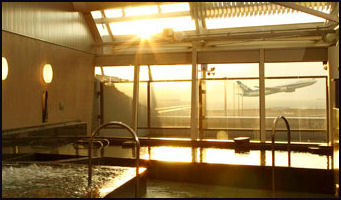
watch the planes take off
while taking a bath (Chubu Cebtair) opened outside Nagoya in February 2005. It is built on a manmade island off Tokoname in Aichi Prefecture and aims to be an international hub and the third major airport in Japan after Narita and Kansai. It opened with 293 international flights, including cargo flights, and 94 domestic flights. It is located far enough from major residential areas that it can operate 24 hours a day.
“Chubu Centrair International Airport is the principal airport for the city of Nagoya. The airport is designed to be easily accessible by everyone, regardless of age or physical disability, incorporating universal design elements such as a design that allows travelers to proceed from the train platform to the arrival or departure lobby without changing floors. Chubu Airport has duty-free shops, shopping arcades, a wide choice of restaurants and even a garden with a wedding venue and baths where one can watch planes land and take off. The airport was very popular with Nagoya residents who visited it as a tourist attraction and a place to enjoy a meal. Chubu Centrair International Airport in Nagoya Chubu Cebtair
Image Sources: 1) map Japan Guest Houses 2) Wikipedia 3) Ray Kinnane 4) Nagoya City site 5) Toyota 6) Aichi Expo 2005 7) Inuyuma City, 8) Meiji Mura, 9) Nagoya city, 10) JNTO 11) 12) 13) 15), 16), 17) Wikipedia, 14) Hida Takayama, 18), 19) Nanto City
Text Sources: JNTO (Japan National Tourist Organization), Japan.org, Japan News, Japan Times, Yomiuri Shimbun, Japan Ministry of the Environment, UNESCO, Japan Guide website, Lonely Planet guides, New York Times, Washington Post, Los Angeles Times, National Geographic, The New Yorker, Bloomberg, Reuters, Associated Press, AFP, Compton's Encyclopedia and various books and other publications.
Updated in July 2020
